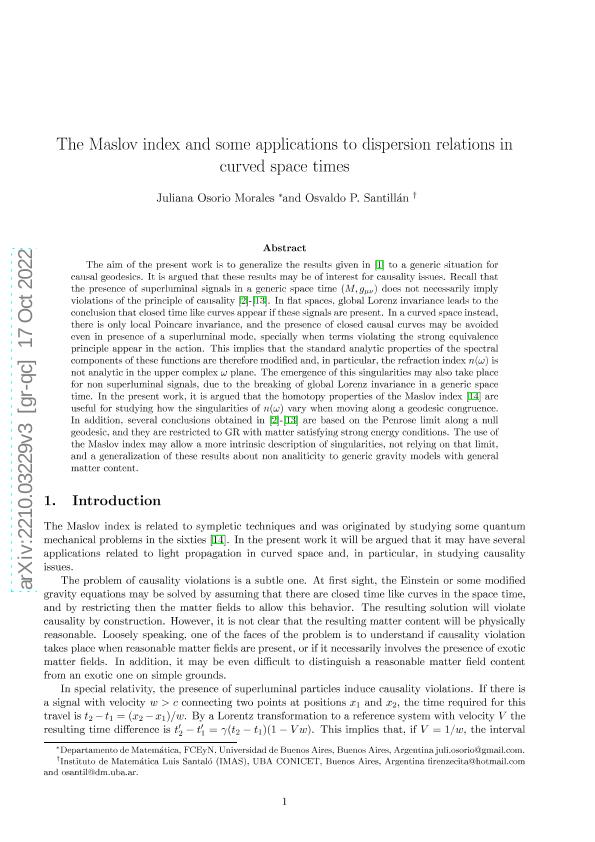Artículo
The Maslov index and some applications to dispersion relations in curved space times
Fecha de publicación:
06/2023
Editorial:
American Institute of Physics
Revista:
Journal of Mathematical Physics
ISSN:
0022-2488
Idioma:
Inglés
Tipo de recurso:
Artículo publicado
Clasificación temática:
Resumen
The aim of the present work is to generalize the results given in Osorio Morales and Santillán [Eur. Phys. J. C 82, 353 (2022)] to a generic situation for causal geodesics. It is argued that these results may be of interest for causality issues. Recall that the presence of superluminal signals in a generic space time (M, gμν) does not necessarily imply violations of the principle of causality {[G. M. Shore, Nucl. Phys. B 778, 219 (2007)] and [T. J. Hollowood and G. M. Shore, Phys. Lett. B 655, 67 (2007)]}. In flat spaces, global Lorenz invariance leads to the conclusion that closed time-like curves appear if these signals are present. In a curved space instead, there is only local Poincare invariance, and the presence of closed causal curves may be avoided even in the presence of a superluminal mode, especially when terms violating the strong equivalence principle appear in the action. This implies that the standard analytic properties of the spectral components of these functions are therefore modified, and in particular, the refraction index n(ω) is not analytic in the upper complex ω plane. The emergence of these singularities may also take place for non-superluminal signals due to the breaking of global Lorenz invariance in a generic space time. In the present work, it is argued that the homotopy properties of the Maslov index are useful for studying how the singularities of n(ω) vary when moving along a geodesic congruence. In addition, several conclusions obtained in Shore [Nucl. Phys. B 778, 219 (2007)] and Hollowood and Shore [Phys. Lett. B 655, 67 (2007)] are based on the Penrose limit along a null geodesic, and they are restricted to GR with matter satisfying strong energy conditions. The use of the Maslov index may allow a more intrinsic description of singularities, not relying on that limit, and a generalization of these results about non-analyticity to generic gravity models with general matter content.
Palabras clave:
MASLOV
,
INDEX
,
CONJUGATE
,
POINTS
Archivos asociados
Licencia
Identificadores
Colecciones
Articulos(IMAS)
Articulos de INSTITUTO DE INVESTIGACIONES MATEMATICAS "LUIS A. SANTALO"
Articulos de INSTITUTO DE INVESTIGACIONES MATEMATICAS "LUIS A. SANTALO"
Citación
Osorio Morales, Maria Juliana; Santillán, Osvaldo Pablo; The Maslov index and some applications to dispersion relations in curved space times; American Institute of Physics; Journal of Mathematical Physics; 64; 6; 6-2023; 1-33
Compartir
Altmétricas




